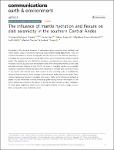The influence of mantle hydration and flexure on slab seismicity in the southern Central Andes
| dc.contributor.author | Rodriguez Piceda, Constanza | |
| dc.contributor.author | Gao, Y-J | |
| dc.contributor.author | Cacace, M | |
| dc.contributor.author | Scheck-Wenderoth, M | |
| dc.contributor.author | Bott, J | |
| dc.contributor.author | Strecker, M | |
| dc.contributor.author | Tilmann, F | |
| dc.date.accessioned | 2023-05-09T15:39:26Z | |
| dc.date.available | 2023-05-09T15:39:26Z | |
| dc.date.issued | 2023-03-17 | |
| dc.identifier.issn | 2662-4435 | |
| dc.identifier.issn | 2662-4435 | |
| dc.identifier.other | 79 | |
| dc.identifier.uri | https://pearl.plymouth.ac.uk/handle/10026.1/20874 | |
| dc.description.abstract |
Knowledge of the causative dynamics of earthquakes along subduction-zone interfaces and within oceanic slabs is relevant for improving future seismic hazard assessments. Here, we combine the analysis of seismic tomography, the 3D structure of the slab and seismicity to investigate the controlling factors driving slab seismic activity beneath the southern Central Andes. We evaluate the ratio distribution between compressional and shear-wave seismic velocities (Vp/Vs) as a proxy for the hydration state of the lithospheric mantle, oceanic slab, and plate interface. Regions of high Vp/Vs, i.e. areas of hydrated mantle, are principally caused by compaction effects and dehydration reactions. In contrast, slab seismicity in areas of low Vp/Vs and inferred lower fluid content in the overriding plate is facilitated by enhanced flexural stresses due to changes in the subduction angle of the oceanic plate. Plate-interface background seismicity correlates with areas of higher Vp/Vs (hydrous interface) at depths <50 km, while areas of most pronounced plate-locking coincide with regions of low Vp/Vs (anhydrous interface). The regions of anhydrous plate interface are likely candidates for future great megathrust events due to their higher potential for elastic energy accumulation compared to more hydrated regions. | |
| dc.format.extent | 79- | |
| dc.language | en | |
| dc.publisher | Springer Science and Business Media LLC | |
| dc.title | The influence of mantle hydration and flexure on slab seismicity in the southern Central Andes | |
| dc.type | journal-article | |
| dc.type | Journal Article | |
| plymouth.author-url | https://www.webofscience.com/api/gateway?GWVersion=2&SrcApp=PARTNER_APP&SrcAuth=LinksAMR&KeyUT=WOS:000952022100001&DestLinkType=FullRecord&DestApp=ALL_WOS&UsrCustomerID=11bb513d99f797142bcfeffcc58ea008 | |
| plymouth.issue | 1 | |
| plymouth.volume | 4 | |
| plymouth.publication-status | Published online | |
| plymouth.journal | Communications Earth & Environment | |
| dc.identifier.doi | 10.1038/s43247-023-00729-1 | |
| plymouth.organisational-group | |Plymouth | |
| plymouth.organisational-group | |Plymouth|Faculty of Science and Engineering | |
| plymouth.organisational-group | |Plymouth|Faculty of Science and Engineering|School of Geography, Earth and Environmental Sciences | |
| plymouth.organisational-group | |Plymouth|Users by role | |
| plymouth.organisational-group | |Plymouth|Users by role|Academics | |
| dcterms.dateAccepted | 2023-02-23 | |
| dc.date.updated | 2023-05-09T15:39:05Z | |
| dc.rights.embargodate | 2023-5-10 | |
| dc.identifier.eissn | 2662-4435 | |
| dc.rights.embargoperiod | forever | |
| rioxxterms.versionofrecord | 10.1038/s43247-023-00729-1 |


